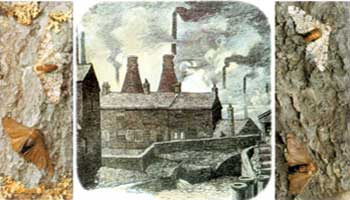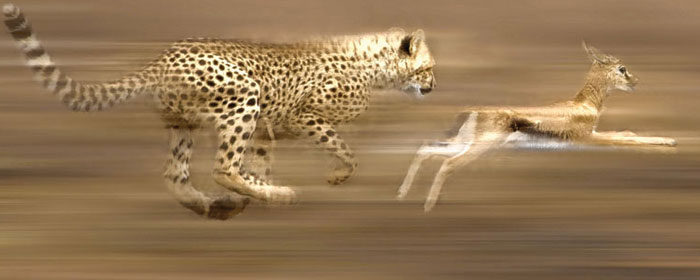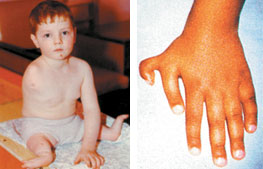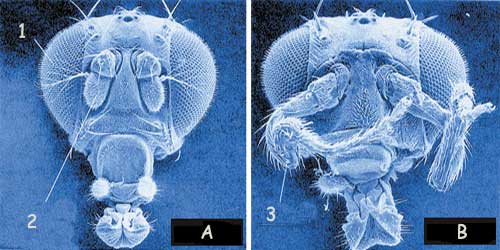The neo-Darwinist model, which we shall take as the mainstream theory of evolution today, argues that life has evolved through two natural mechanisms: "natural selection" and "mutation". The theory basically asserts that natural selection and mutation are two complementary mechanisms. The origin of evolutionary modifications lies in random mutations that take place in the genetic structures of living things. The traits brought about by mutations are selected by the mechanism of natural selection, and by this means living things evolve.
When we look further into this theory, we find that there is no such evolutionary mechanism. Neither natural selection nor mutations make any contribution at all to the transformation of different species into one another, and the claim that they do is completely unfounded.
As process of nature, natural selection was familiar to biologists before Darwin, who defined it as a "mechanism that keeps species unchanging without being corrupted". Darwin was the first person to put forward the assertion that this process had evolutionary power and he then erected his entire theory on the foundation of this assertion. The name he gave to his book indicates that natural selection was the basis of Darwin's theory: The Origin of Species, by means of Natural Selection...
However since Darwin's time, there has not been a single shred of evidence put forward to show that natural selection causes living things to evolve. Colin Patterson, the senior paleontologist of the British Museum of Natural History in London and a widely known evolutionist, stresses that natural selection has never been observed to have the ability to cause things to evolve:
No one has ever produced a species by mechanisms of natural selection. No one has ever got near it and most of the current argument in neo-Darwinism is about this question.15
Natural selection holds that those living things that are more suited to the natural conditions of their habitats will prevail by having offspring that will survive, whereas those that are unfit will disappear. For example, in a deer herd under the threat of wild animals, naturally those that can run faster will survive. That is true. But no matter how long this process goes on, it will not transform those deer into another living species. The deer will always remain deer.
When we look at the few incidents the evolutionists have put forth as observed examples of natural selection, we see that these are nothing but a simple attempt to hoodwink.
 |
Industrial Melanism is certainly not an evidence for evolution because the process did not produce any new species of moths. The selection was only among already existing varieties. Moreover, the classical story of melanism is deceptive. The textbook pictures above (portrayed as genuine photos) are in fact of dead specimens glued or pinned to tree trunks by evolutionists. |
In 1986 Douglas Futuyma published a book, The Biology of Evolution, which is accepted as one of the sources explaining the theory of evolution by natural selection in the most explicit way. The most famous of his examples on this subject is about the colour of the moth population, which appeared to darken during the Industrial Revolution in England. It is possible to find the story of the Industrial Melanism in almost all evolutionist biology books, not just in Futuyma's book. The story is based on a series of experiments conducted by the British physicist and biologist Bernard Kettlewell in the 1950s, and can be summarised as follows:
According to the account, around the onset of the Industrial Revolution in England, the colour of the tree barks around Manchester was quite light. Because of this, dark-coloured (melanic) moths resting on those trees could easily be noticed by the birds that fed on them and therefore they had very little chance of survival. Fifty years later, in woodlands where industrial pollution has killed the lichens, the barks of the trees had darkened, and now the light-colored moths became the most hunted, since they were the most easily noticed. As a result, the proportion of light-coloured moths to dark-coloured moths decreased. Evolutionists believe this to be a great piece of evidence for their theory. They take refuge and solace in window-dressing, showing how light-coloured moths "evolved" into dark-coloured ones.
However, even if we assume these to be correct, it should be quite clear that they can in no way be used as evidence for the theory of evolution, since no new form arose that had not existed before. Dark colored moths had existed in the moth population before the Industrial Revolution. Only the relative proportions of the existing moth varieties in the population changed. The moths had not acquired a new trait or organ, which would cause "speciation". In order for one moth species to turn into another living species, a bird for example, new additions would have had to be made to its genes. That is, an entirely separate genetic program would have had to be loaded so as to include information about the physical traits of the bird.
This is the answer to be given to the evolutionist story of Industrial Melanism. However, there is a more interesting side to the story: Not just its interpretation, but the story itself is flawed. As molecular biologist Jonathan Wells explains in his book Icons of Evolution, the story of the peppered moths, which is included in every evolutionist biology book and has therefore, become an "icon" in this sense, does not reflect the truth. Wells discusses in his book how Bernard Kettlewell's experiment, which is known as the "experimental proof" of the story, is actually a scientific scandal. Some basic elements of this scandal are:
These facts were uncovered by the scientific community only in the late 1990s. The collapse of the myth of Industrial Melanism, which had been one of the most treasured subjects in "Introduction to Evolution" courses in universities for decades, greatly disappointed evolutionists. One of them, Jerry Coyne, remarked:
My own reaction resembles the dismay attending my discovery, at the age of six, that it was my father and not Santa who brought the presents on Christmas Eve.17
Thus, "the most famous example of natural selection" was relegated to the trash-heap of history as a scientific scandal which was inevitable, because natural selection is not an "evolutionary mechanism," contrary to what evolutionists claim. It is capable neither of adding a new organ to a living organism, nor of removing one, nor of changing an organism of one species into that of another.
There is nothing that natural selection contributes to the theory of evolution, because this mechanism can never increase or improve the genetic information of a species. Neither can it transform one species into another: a starfish into a fish, a fish into a frog, a frog into a crocodile, or a crocodile into a bird. The biggest defender of punctuated equilibrium, Stephen Jay Gould, refers to this impasse of natural selection as follows;
 |
Natural selection serves as a mechanism of eliminating weak individuals within a species. It is a conservative force which preserves the existing species from degeneration. Beyond that, it has no capability of transforming one species to another |
The essence of Darwinism lies in a single phrase: natural selection is the creative force of evolutionary change. No one denies that selection will play a negative role in eliminating the unfit. Darwinian theories require that it create the fit as well.18
Another of the misleading methods that evolutionists employ on the issue of natural selection is their effort to present this mechanism as conscious. However, natural selection has no consciousness. It does not possess a will that can decide what is good and what is bad for living things. As a result, one cannot explain biological systems and organs that possess the feature of "irreducible complexity" by natural selection. These systems and organs are composed of a great number of parts cooperating together, and are of no use if even one of these parts is missing or defective. (For example, the human eye does not function unless it exists with all its components intact). Therefore, the will that brings all these parts together should be able to foresee the future and aim directly at the advantage that is to be acquired at the final stage.
Since natural selection has no consciousness or will, it can do no such thing.This fact, which demolishes the foundations of the theory of evolution, also worried Darwin, who wrote: "If it could be demonstrated that any complex organ existed, which could not possibly have been formed by numerous, successive, slight modifications, my theory would absolutely break down." .19
Through natural selection only the disfigured, weak, or unfit individuals of a species are selected out. New species, new genetic information, or new organs cannot be produced. That is, living things cannot evolve through natural selection. Darwin accepted this reality by saying: "Natural selection can do nothing until favourable variations chance to occur".20This is why neo-Darwinism has had to elevate mutations next to natural selection as the "cause of beneficial changes". However as we shall see, mutations can only be "the cause for harmful changes".
 |
Mutations add no new information to an organism's DNA: As a result of mutations, the particles making up the genetic information are either torn from their places, destroyed, or carried off to different places. Mutations cannot make a living thing acquire a new organ or a new trait. They only cause abnormalities like a leg sticking out of the back, or an ear from the abdomen. |
Mutations are defined as breaks or replacements taking place in the DNA molecule, which is found in the nuclei of the cells of a living organism and which contains all its genetic information. These breaks or replacements are the result of external effects such as radiation or chemical action. Every mutation is an "accident" and either damages the nucleotides making up the DNA or changes their locations. Most of the time, they cause so much damage and modification that the cell cannot repair them.
Mutation, which evolutionists frequently hide behind, is not a magic wand that transforms living organisms into a more advanced and perfect form. The direct effect of mutations is harmful. The changes effected by mutations can only be like those experienced by people in Hiroshima, Nagasaki, and Chernobyl: that is, death, disability, and sickness…
The reason for this is very simple: DNA has a very complex structure, and random effects can only damage the organism. B.G. Ranganathan states:
First, genuine mutations are very rare in nature. Secondly, most mutations are harmful since they are random, rather than orderly changes in the structure of genes; any random change in a highly ordered system will be for the worse, not for the better. For example, if an earthquake were to shake a highly ordered structure such as a building, there would be a random change in the framework of the building which, in all probability, would not be an improvement. 21
Not surprisingly, no useful mutation has been so far observed. All mutations have proved to be harmful. The evolutionist scientist Warren Weaver comments on the report prepared by the Committee on Genetic Effects of Atomic Radiation, which had been formed to investigate mutations that might have been caused by the nuclear weapons used in the Second World War:
Many will be puzzled about the statement that practically all known mutant genes are harmful. For mutations are a necessary part of the process of evolution. How can a good effect - evolution to higher forms of life - results from mutations practically all of which are harmful? 22
Every effort put into "generating a useful mutation" has resulted in failure. For decades, evolutionists carried out many experiments to produce mutations in fruit flies as these insects reproduce very rapidly and so mutations would show up quickly. Generation upon generation of these flies were mutated, yet no useful mutation was ever observed. The evolutionist geneticist Gordon Taylor writes thus:
It is a striking, but not much mentioned fact that, though geneticists have been breeding fruit-flies for sixty years or more in labs all around the world-flies which produce a new generation every eleven days-they have never yet seen the emergence of a new species or even a new enzyme.23
Another researcher, Michael Pitman, comments on the failure of the experiments carried out on fruit flies:
Morgan, Goldschmidt, Muller, and other geneticists have subjected generations of fruit flies to extreme conditions of heat, cold, light, dark, and treatment by chemicals and radiation. All sorts of mutations, practically all trivial or positively deleterious, have been produced. Man-made evolution? Not really: Few of the geneticists' monsters could have survived outside the bottles they were bred in. In practice mutants die, are sterile, or tend to revert to the wild type.24
 |
A disastrous effect of mutations on the human body. (right)The boy at left is a Chernobyl nuclear plant accident victim. |
The same holds true for man. All mutations that have been observed in human beings have had deleterious results. On this issue, evolutionists throw up a smokescreen and try to enlist examples of even such deleterious mutations as "evidence for evolution". All mutations that take place in humans result in physical deformities, in infirmities such as mongolism, Down syndrome, albinism, dwarfism or cancer. These mutations are presented in evolutionist textbooks as examples of "the evolutionary mechanism at work". Needless to say, a process that leaves people disabled or sick cannot be "an evolutionary mechanism"-evolution is supposed to produce forms that are better fitted to survive.
To summarise, there are three main reasons why mutations cannot be pressed into the service of supporting evolutionists' assertions:
l) The direct effect of mutations is harmful: Since they occur randomly, they almost always damage the living organism that undergoes them. Reason tells us that unconscious intervention in a perfect and complex structure will not improve that structure, but will rather impair it. Indeed, no "useful mutation" has ever been observed.
2) Mutations add no new information to an organism's DNA: As a result of mutations, the particles making up the genetic information are either torn from their places, destroyed, or carried off to different places. Mutations cannot make a living thing acquire a new organ or a new trait. They only cause abnormalities like a leg sticking out of the back, or an ear from the abdomen.
3) In order for a mutation to be transferred to the subsequent generation, it has to have taken place in the reproductive cells of the organism: A random change that occurs in a cell or organ of the body cannot be transferred to the next generation. For example, a human eye altered by the effects of radiation or by other causes will not be passed on to subsequent generations.
It is impossible for living beings to have evolved, because there exists no mechanism in nature that can cause evolution. Furthermore, this conclusion agrees with the evidence of the fossil record, which does not demonstrate the existence of a process of evolution, but rather just the contrary.
All Mutations are Harmful | |
 | |
A. NORMAL 1. Eye, 2. Antenna | B. MUTANT 3. Leg |
A normal fruit fly (drosophila). | A fruit fly with its legs jutting from its head; a mutation induced by radiation. |
15. Colin Patterson, "Cladistics", Brian Leek ile Röportaj, Peter Franz, 4 Mart 1982, BBC![]()
16. Jonathan Wells, Icons of Evolution: Science or Myth? Why Much of What We Teach About Evolution is Wrong, Regnery Publishing, 2000, s. 141-151![]()
17. Jerry Coyne, "Not Black and White", a review of Michael Majerus's Melanism: Evolution in Action, Nature, 396 (1988), pp. 35-36![]()
18. Stephan Jay Gould, "The Return of Hopeful Monsters", Natural History, cilt 86, Temmuz-Ağustos 1977, s. 28![]()
19. Charles Darwin, The Origin of Species: A Facsimile of the First Edition, Harvard University Press, 1964, s. 189![]()
20. Charles Darwin, The Origin of Species, s. 177![]()
21. B. G. Ranganathan, Origins?, Pennsylvania: The Banner Of Truth Trust, 1988![]()
22. Warren Weaver, "Genetic Effects of Atomic Radiation", Science, Cilt 123, 29 Haziran, 1956, s. 1159![]()
23. Gordon R. Taylor, The Great Evolution Mystery, New York, Harper & Row, 1983, s. 48![]()
24. Michael Pitman, Adam and Evolution, London: River Publishing, 1984, s. 70![]()